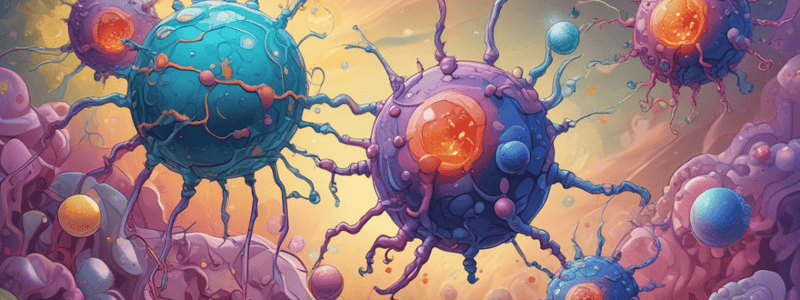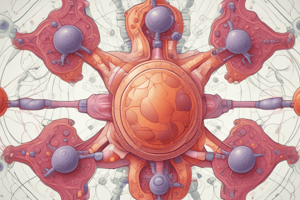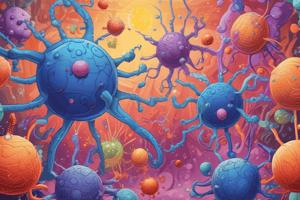Podcast
Questions and Answers
What is the main function of the variable region in an antibody?
What is the main function of the variable region in an antibody?
- To classify antibodies into different classes
- To give the antibody its specificity (correct)
- To determine the mechanism used to destroy antigen
- To form a 'Y' shaped molecule
What is the main difference between the different classes of antibodies?
What is the main difference between the different classes of antibodies?
- The structure of the variable region
- The number of polypeptide chains
- The number of amino acids in the variable region
- The constant region structure and immune function (correct)
How many polypeptide chains are present in an antibody?
How many polypeptide chains are present in an antibody?
- 4 (correct)
- 3
- 2
- 6
What is the term for the proteins that antibodies are a type of?
What is the term for the proteins that antibodies are a type of?
What is the shape of an antibody molecule?
What is the shape of an antibody molecule?
What is the function of the region at the tips of the 'Y' shaped antibody molecule?
What is the function of the region at the tips of the 'Y' shaped antibody molecule?
What is the basis for dividing antibodies into 5 major classes?
What is the basis for dividing antibodies into 5 major classes?
What is the characteristic of the acid sequence in the tips of the 'Y' shaped antibody molecule?
What is the characteristic of the acid sequence in the tips of the 'Y' shaped antibody molecule?
What is the role of the constant region in an antibody?
What is the role of the constant region in an antibody?
What is the number of acid residues in the region that gives the antibody specificity?
What is the number of acid residues in the region that gives the antibody specificity?
Flashcards are hidden until you start studying
Study Notes
Antibody Structure
- Antibodies are proteins called immunoglobulins, consisting of four polypeptides: two heavy chains and two light chains, forming a "Y" shaped molecule.
Antibody Specificity
- The amino acid sequence at the tips of the "Y" shape (110-130 amino acids) varies among different antibodies, giving each antibody its specificity.
Antibody Function
- The constant region of an antibody determines the mechanism used to destroy antigens.
Antibody Classification
- Antibodies are divided into 5 major classes: IgM, IgG, IgA, IgD, and IgE, based on their constant region structure and immune function.
Antibody Structure
- Antibodies are proteins called immunoglobulins, consisting of four polypeptides: two heavy chains and two light chains, forming a "Y" shaped molecule.
Antibody Specificity
- The amino acid sequence at the tips of the "Y" shape (110-130 amino acids) varies among different antibodies, giving each antibody its specificity.
Antibody Function
- The constant region of an antibody determines the mechanism used to destroy antigens.
Antibody Classification
- Antibodies are divided into 5 major classes: IgM, IgG, IgA, IgD, and IgE, based on their constant region structure and immune function.
Studying That Suits You
Use AI to generate personalized quizzes and flashcards to suit your learning preferences.




